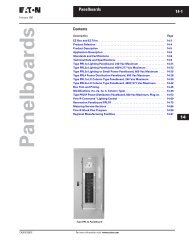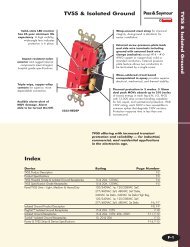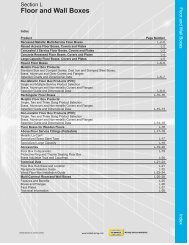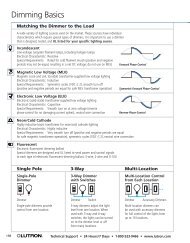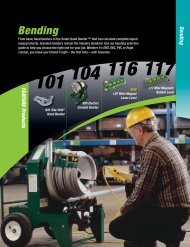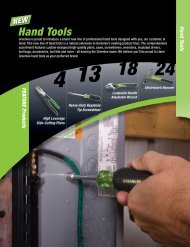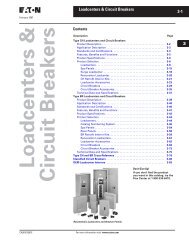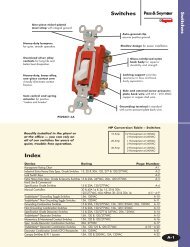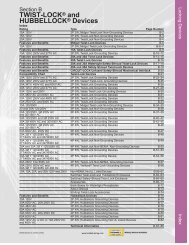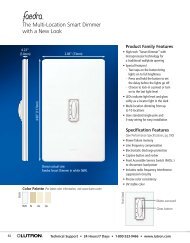Leviton Catalog - Womack Electric Supply Company
Leviton Catalog - Womack Electric Supply Company
Leviton Catalog - Womack Electric Supply Company
- No tags were found...
You also want an ePaper? Increase the reach of your titles
YUMPU automatically turns print PDFs into web optimized ePapers that Google loves.
TECHNICAL INFORMATIONTelephone Wiring Devices Codes and StandardsIndustry StandardsAt <strong>Leviton</strong>, our concern since deregulation has been the proliferation ofpoor quality devices and equipment being attached to the network.These devices meet few of the customary standards for mechanicalintegrity and combustibility and have caused a number of problems forthose who have installed them.The responsibility for ensuring that no sub-standard devices are connectedto the network rests on everyone’s shoulders. In fact, the FCCrecently issued a Public Notice strongly reminding manufacturers, carriersand customers that the manufacture and installation of substandarddevices and equipment will not be tolerated — and that asubstantial fine is the penalty for noncompliance. Recently, organizationssuch as the Federal Communications Commission (FCC),Underwriter’s Laboratories (UL), the Canadian Standards Association(CSA), and the Telecommunications Industry Association (TIA) havebeen developing standards for premise wiring systems, Additionally,Article 800 of the National <strong>Electric</strong>al Code (NEC), published by theNational Fire Protection Association (NFPA), mandated “listing” ofequipment connected to telecommunications networks. <strong>Leviton</strong> hasalways played a role in the standards-making process and will continueto do so. We wholeheartedly support this new standards environment.■ The “extraordinary procedures,” acceptance testing, and carrier notificationfor wiring clause has been eliminated. The carrier is no longerrequired to take steps to protect the network from harm when there isa violation of Part 68 a failure during testing of newly installed wiring,or when harm has actually occurred. Once again, because the carriersnow have less access to the customer premise, they will also haveless responsibility in maintaining the network.■ Customer-provided, as well as carrier-provided plugs and jacks mustmeet Subpart F of Part 68 when newly installed on or after January 1,1991. Prior to this ruling, Part 68 could be interpreted to require thatonly the jack at the network interface conform to Part 68.Beware of the Number GameFCC Part 68, Subpart F, specifies that contacts in the telephone jacksmust have 50 micro-inches of gold over 100 micro-inches of nickel.Some manufacturers claim .5 microns of gold plating on their jack contacts.At 39.37 micro-inches per micron, that’s only 19.7 micro-inches— less than half of what is required to meet FCC Part 68 specifications.If jack contacts have not been plated with the right thickness or qualityof gold, corrosion at these critical points can cause signal degradation,equipment failure, and even damage to the public telephone network.Data networks are more at risk because even slight imperfections resultin transmission error or data loss.Industry Basics: Drawing the LineThe dividing line between public network and customer premises iscalled the demarcation point. Equipment, including wiring, on the networkside of the demarcation point is the property and responsibility ofthe local telephone company (telco). Equipment and wiring on thecustomer side is the responsibility of the customer, who may procureequipment, materials, and service from the provider of their choice. Asubscriber network interface (SNI) often called a “demarcation jack”, isrecommended to be installed at the demarcation point. A standardregistered jack is often used at this point so that the network and thepremise wiring system can be quickly separated from each other. Thelocation of the SNI depends on local rules and on such factors as thenumber of units in the facility, access, and the type and age of connectinghardware. The SNI may be inside the building or outside.FCC Part 68 RequirementsThe equipment standards outlined in FCC Part 68 were developed longbefore divestiture to assure consumers, manufacturers and carriersthat terminal equipment and wiring could be connected withoutdegrading the network. Part 68 describes minimum requirements forthe mechanical or physical properties of wiring devices such as theamount of gold on jack contacts, electrical performance, dimensionalintegrity, material properties, and spring characteristics of contacts.Only equipment meeting FCC Part 68 standards may be manufacturedand connected to the network. The vast changes that have occurred inthe industry because of evolving deregulation have made it necessaryto modify Part 68. To this end, FCC Wiring Docket 88-57 was issued in1990. There have been numerous attempts to change this docket;however, as of this writing, the following guidelines are true:■ Since 1984, Part 68 specified that all connections to the network bemade through the standard plugs and standard telephone companyprovidedjacks described in Subpart F or Part 68. Now, Docket 88-57permits customers to connect to the carrier’s jack or wiring.■ The demarcation point has been redefined to be not more than 12inches from the protector, or when no protector is present, 12 inchesfrom the point of entry to the premises. In the past, the demarcationpoint could extend into the customer premise hundreds of feet, ifnecessary, depending on the wiring application. The new 12-inch rulinglimits the carrier’s access to the customer premise.■ The carriers are not responsible for customer wiring unless they havean agreement for such responsibility. Because the customer can nowinstall a jack at the network interface, the customer is responsible forany wiring errors and malfunctions that occur.Reduce Risks — Specify <strong>Leviton</strong>There are no two ways about it. The risk to your operation and equipmentis so great that it only makes sense to insist on top-quality stationproducts. When you specify <strong>Leviton</strong> jacks, you’re assured maximumcontact life with minimum resistance. We start with durable phosphorbronzecontacts and plate them with a full 50 micro-inches of lubricatedhard gold over 100 micro-inches of nickel (or the electricalperformance equivalent as specified in FCC Part 68 requirements).Jack openings are built within precise tolerances. High-quality thermoplasticrated UL 94V-0 resists distortion from changes in temperatureand humidity, physical stress, and aging. Spring contacts are engineeredto maintain positive contact pressure over the life of the device.Telecommunications Industry Association StandardsIf FCC regulations protect the telephone network from harm and ULrequirements protect the consumer from harm, who is responsible forproviding performance standards for the telecommunications industry?Recently, the FCC asked the Telecommunications Industry Association(TIA), a sister organization of the Electronic Industries Association (EIA),to take on this task, and they accepted the challenge. The TIA wasasked to define minimum standards for such things as how to wire abuilding, what kind of wire to use, and so on. The following standardswent into effect in 1991.■ Pathway Standard (EIA/TIA 569-A): This standard for installing pipeand conduit in commercial buildings is now available through TIAand the American National Standards Institute (ANSI).■ Residential/Light Commercial Wiring (EIA/TIA 570): A draft of thisstandard, which applies to premises with up to four telephone lines,has been reviewed by ANSI and TIA committees and released.■ Commercial Wiring Standard (EIA/TIA 568-A): The Commercial WiringStandard applies to premises with more than four telephone lines.This draft has also been reviewed and released by ANSI and TIAcommittees. At time of printing, the standards are undergoing majorrevisions and are currently up for ballot.We’re the “Standards” PeopleBecause <strong>Leviton</strong> is an active participant in the formation of NorthAmerican codes and standards, you can be assured that our productdevelopment activities fully support this emerging standards environment.In fact. we have prepared several publications which describestandard practices and provide installation guidelines for contractors.Many <strong>Leviton</strong> distributors also sponsor training programs dealing withtelecom wiring. And, of course, <strong>Leviton</strong>’s Applications EngineeringGroup is always ready to assist you with any questions you may haveabout standards and codes, standard practices, or any installationproblem.Technical InformationFor answers to technical questions, call <strong>Leviton</strong>’s Techline at 1-800-824-3005V27



